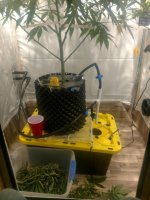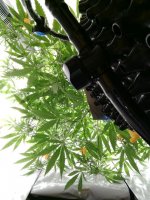Dankman_420
Well-Known Member
I've tried searching on zon with little results. I'll have to check alli too. Maybe my search tag is not correct. Lol
How To Use Progressive Web App aka PWA On 420 Magazine Forum
Note: This feature may not be available in some browsers.
If you guys don't mind me asking. How much money do you have invested in your lights

Another crucial detail why they recommended your kit be configured that way is because you have 140mm passive pin heat sinks and they can only dissipate 80 watts of heat max. If you drove those pucks to the full 2800ma, you'd likely burn them out unless you had active cooling. If you troll around on Digikey or other electronics dealers, you can find a lot of active cooling options that will replace our pinned heatsinks and they can wisk away the heat into the surrounding area, unless you make something of a cool tube or other means of discarding heat quickly. Though active cooling requires a fan per heatsink which increases your wires by 6 more, and those fans need a different voltage so you'd have to work that out, and some more yada yada yada and you can appreciate the simplicity of the passive pinned heat sinks which are very difficult to locate on the web ironicly. But those active coolers are very easy to find and price.
I suggest getting your output up to 100%, and observe driver temps and heat sink temps. Common sense will tell you if you're pushing either too hard. 20" away from the canopy is plenty, so I doubt the intensity would manifest in slowed growth.
Did you get your kit from Rapid? I was only able to locate their 4 puck kit for $449.
DIY COB LED Fixture Panels by Skybound420
/QUOTE]
what a super job you did there with your panels mr bound,, great stuff.
@Tead what I don't like about the QBs is because the diodes are spread out, the light intensity will decay in a shorter distance than light from COBs. It would be nice if they made QBs with clusters of diodes to create some intensity while also using the wide spread diodes. Kind of 'best of both worlds' scenario.
 ......no wonder you have so much money invested. I have a 48"x32"x60" tent coming. Lol
......no wonder you have so much money invested. I have a 48"x32"x60" tent coming. Lol@Tead what I don't like about the QBs is because the diodes are spread out, the light intensity will decay in a shorter distance than light from COBs. It would be nice if they made QBs with clusters of diodes to create some intensity while also using the wide spread diodes. .
the way I see it, the COBs have the ability to shine light through leaves
I feel that maybe your definition of penetration differs from the industry ideas about it.
Honestly, I think you're specifically off base on any ideas of light passing thru one leaf and providing any usable power 2nd hand. You could easily test the concept tho. Turn on one light and cover that light closely with 1 leaf right at the light source. I bet you'll find that it actually blocks most of the light and not much usable light passes thru the plant mass.
In my eye, when 'Penetration' is mentioned, folks are referring to the light that is not blocked and hits the lower growth.
When I hear penetration, I am lead to believe that it means the ability to retain strength, or quality of light,
Thats probably true. I haven't done the math...Sounds reasonable though...Well.... I'm no electrical engineer, but I might wonder if your 'chinese light' vendor (all lights have probably been produced in China for many years) already took care of it and gave you a panel with about 10% more capacity than your driver produces? My vendor in China sent me exactly that configuration... that's all they had for sale.... I might suspect this is the standard. If i wanted to actually power the panels to full capacity, I would have needed to special order a larger ballast.
Check your numbers.... I bet you're in the same boat and just don't realize it.

